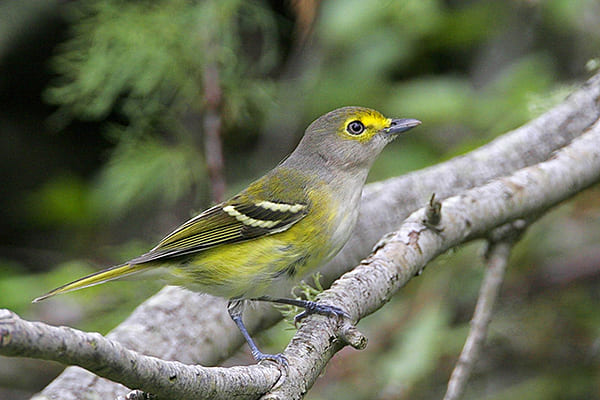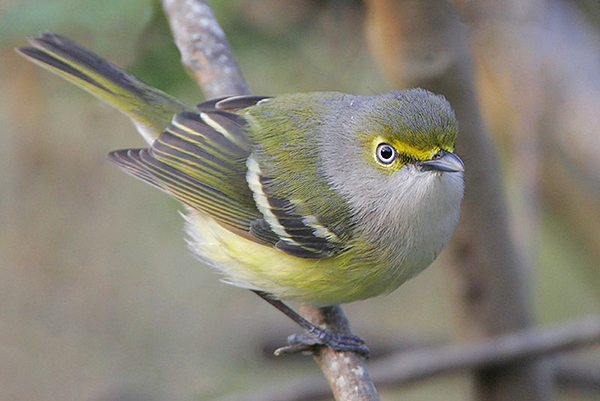Have you seen or heard about the White-eyed Vireo (Vireo griseus)? These birds are not as known as some other birds but they’re actually very interesting. For example, did you know that in Bermuda, the White-eyed Vireo is widely known as ‘chick-of-the-village’. This bird is very common in Bermuda which is how it earned its nickname.
These birds are very widespread and common across a good portion of the eastern U.S. They can be seen year-round in Common year-round in Florida and along the gulf coast.

On this page
Identification
Both genders of the White-eyed Vireos are hard to differentiate because they look very similar in many aspects.
Both males and females have olive-green or olive-yellow upperparts, gray heads and napes, and the face catches the eye with the bright yellow that causes the birds to have thick lines around their eyes.
The abdomen and chest are white, the upper legs are yellow, and the tail feathers are white as well. The wings are mostly black with green-yellow edges and two pale yellow or thin white wing bars. The feet and legs are a darker gray. Lastly, the eyes have irises that are bright white.
Juvenile
Juvenile White-eyed Vireos look very similar to the adults, but they’re overall paler.
The face is plain and doesn’t have bright yellow above the bill. The only yellow we see is a pale yellow eye ring. Juvenile birds also have eyes that are darker; they lighten as they mature. The eyes are usually either gray or brownish.
Both the male and the female White-eyed Vireo share incubation duties for 13 – 16 days. Then, after the nestlings hatch, the parents share feeding responsibilities for 10 – 11 days until the young birds leave the nest.
Habitat
White-eyed Vireos are a common southeastern U.S.
They can be found in brush, wood edges, and undergrowth. They breed in different kinds of dense low growth, including shrubby thickets of maple, briar tangles on low swampy ground, saplings in overgrown pastures, and scrub near forest edges or in open woods.
Diet
A White-eyed Vireo’s diet is primarily made up of insects and berries. During breeding season, they almost only eat insects. Some of the insects they eat are flies, caterpillars, beetles, butterflies, moths, leafhoppers, spiders, and lacewings. They’ll sometimes eat snails and small lizards as well.
During migration and in the winter, they eat berries and other small fruits. White-eyed Vireos can be seen foraging in a very deliberate way.
They’ll slowly hop along while looking around before grabbing whatever they see for food. These Vireos swallow smaller items whole, but if they find themselves dealing with larger prey, they’ll pin it down with their foot before consuming it.
Behavior
White-eyed Vireos make short flights between shrubs and hop along branches; this keeps them well hidden. Males will sing from the edges of the underbrush all day long, even during the hottest part of the day.
Male White-eyed Vireos defend their territories against other males by fluffing, sleeking their feathers, pecking at their perch or feet, and flicking their wings. Males start to court females soon after they arrive, and once a pair is made a monogamous bond is made and maintained during the entirety of the breeding season.
Range (and seasonal changes)
White-eyed Vireos breed throughout a lot of the eastern United States. Breeding extends all the way north to Massachusetts. They are commonly seen along the gulf coast and into Florida in winter. However, even though they’re more common in the areas during the winter, they can be seen in these areas year-round. During the non-breeding season, White-eye Vireos can be seen in the Belize Honduras, Yucatan Peninsula, parts of the Caribbean, and parts of the Bahamas.
Fun Facts
- Only male White-eyed Vireos sing on breeding grounds. However, both male and female White-eyed Vireos sing on wintering grounds.
- North America has only one fossil record for the whole vireo family. Scientists found a 400,000-year-old wing bone from a White-eyed Vireo in Florida from the late Pleistocene period.
- White-eyed Vireos have an interesting way of bathing. They rub their bodies against saturated foliage during the morning.
- The oldest recorded bird of this species was at least ten years and eleven months old. The male Vireo was recorded again during banding operations in Louisiana. Louisiana was the state he was initially banded in.

Vocalization
The White-eyed Vireo’s song is nasal, rapid, and harsh, with sharp chips at the beginning and end of the song. They sing several different sequences of notes, repeating each sequence several times before switching to a new sequence. White-eyed Vireos are even known to mimic other bird sounds, often sounding like a Gray Catbird. These Vireos sing at all times of the day, but you’ll hear more frequent vocalizations at dusk and dawn.
Their calls include a harsh, nasal mew and a short zip that somewhat sounds like a Blue-gray Gnatcatcher. Some suggest that they sing “Spit. And see if I care. Spit.” while others say, they sing “Pik-chicka-weew.”
FAQ
Is the White-eyed Vireo endangered?
No, White-eyed Vireos are not endangered. They’re a common bird and the estimated worldwide breeding population is twenty-one million. The species rates an eight out of twenty on the Continental Concern Score. This means the species is of low concern.
Where do White-eyed Vireos live?
White-eyed Vireos live in overgrown pastures, deciduous scrub, old fields, second-growth forests, and forested edges. In Florida, they can also be seen in the mangroves.
What does a White-eyed Vireo say?
Sople suggest that White-eyed Vireos sing “Spit. And see if I care. Spit”. while others say, they sing “Pik-chicka-weew.”
Similar Species
- The Bell’s Vireo is much plainer and has dark eyes.

